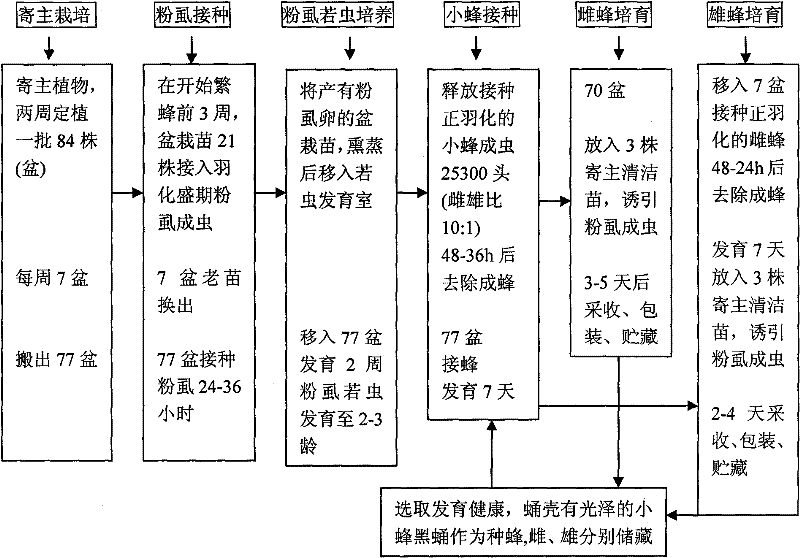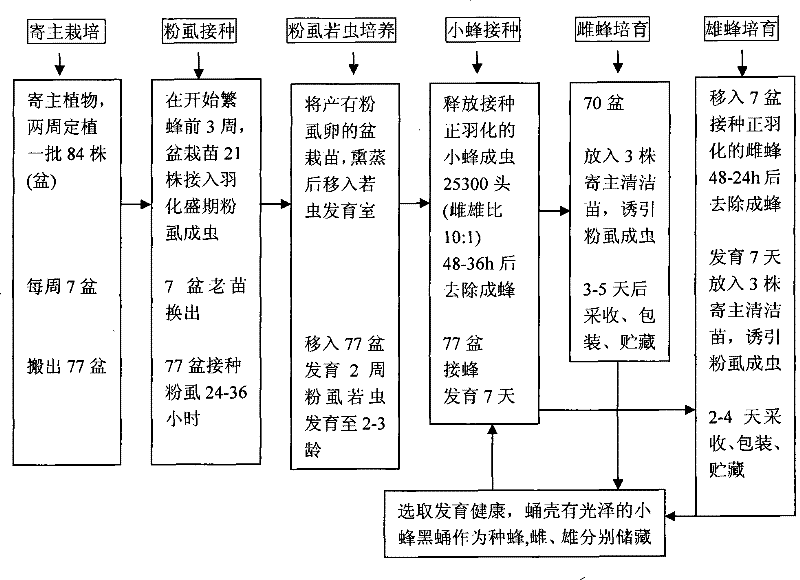Encarsia Sophia artificial propagation production method
A technology for artificial reproduction of the pale yellow nephew aphid, applied in hunting equipment, applications, animal husbandry and other directions, can solve problems such as difficulty in mass reproduction, and achieve the effects of improving egg hatching rate, mass reproduction, and good natural control.
- Summary
- Abstract
- Description
- Claims
- Application Information
AI Technical Summary
Problems solved by technology
Method used
Image
Examples
Embodiment 1
[0050] Example 1: Mass production and reproduction of Aphididae
[0051] The mass production and reproduction process of the yellow aphid bee is mainly as follows figure 1 As shown, the details are as follows:
[0052] 1. Collect and reproduce the bee species of Aphididae
[0053] (1) Collecting bee species: Collect the whitefly nymphs parasitized by the small yellow aphid, that is, black pupae on the leaves of field plants where whiteflies are severely infested;
[0054] (2) Purification and optimization of bee species: The collected parasitic black pupae of Aphididae were placed at 25-27°C and RH.60-70% to develop, and the queen bee emerged and transferred to the body of the whitefly nymph , And then select good bee species by testing the parasitism rate, emergence rate, fecundity, sex ratio, storage characteristics and the ability to search for the target pest eggs;
[0055] (3) Breeding of bee species: expand the female and male species of Aphis sibiricus respectively, and accumul...
Embodiment 2
[0080] Example 2: Comparative experiment
[0081] Comparative experiment 1: Screening of host plants
[0082] (1) Materials and methods
[0083] i) Test insects
[0084] Bemisia tabaci was collected from tomato plants in the greenhouse of Beijing Academy of Agriculture and Forestry Sciences.
[0085] The yellow aphid (black pupae) came from the Agricultural Experimental Station of Texas A&M University, USA.
[0086] ii) Host plant
[0087] Beans, cucumbers, cotton, poinsettia, cabbage, sweet potatoes, and tomatoes were the test hosts.
[0088] Beans, cucumber, cabbage, and tomato seeds were purchased from the Special Vegetable Center of the Vegetable Institute of Beijing Academy of Agriculture and Forestry Sciences. Cotton and sweet potatoes were provided by the Institute of Zoology, Chinese Academy of Sciences, and poinsettia was purchased from a Beijing supermarket.
[0089] iii) Experimental conditions and equipment
[0090] It is carried out indoors, the temperature is controlled at 25-...
PUM
 Login to View More
Login to View More Abstract
Description
Claims
Application Information
 Login to View More
Login to View More - R&D
- Intellectual Property
- Life Sciences
- Materials
- Tech Scout
- Unparalleled Data Quality
- Higher Quality Content
- 60% Fewer Hallucinations
Browse by: Latest US Patents, China's latest patents, Technical Efficacy Thesaurus, Application Domain, Technology Topic, Popular Technical Reports.
© 2025 PatSnap. All rights reserved.Legal|Privacy policy|Modern Slavery Act Transparency Statement|Sitemap|About US| Contact US: help@patsnap.com



